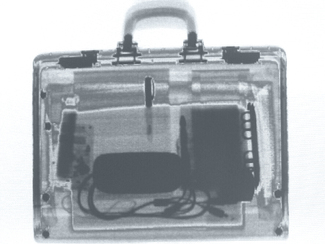
Baggage screening has been established worldwide to enhance air traffic security and is performed by means of so-called X-ray scanners. These X-ray scanners are designed in a way that only a very small fraction of the X-rays used for internal screening can be measured outside the machine.
 Source: Firma Apollo
Source: Firma Apollo
Ionising smoke detectors (ISM) are equipments that contain radioactive materials, mostly Americium-241. The radiation of the radioactive material ionizes the air located in the smoke detectors. The induced ionisation current changes if smoke aerosols entered the ISM. This is used to create a smoke alarm.
The type approval of X-ray devices for non-medical purposes as well as of parasitic X-ray emitters (equipment with unintended X-ray emission) is regulated by §§ 8 to 12 together with Annexes 1 and 2 of the X-ray Ordinance – RoeV (Ordinance on the Protection against Damage and Injuries Caused by X-rays).
According to § 8 (6) RöV, the Federal Office for Radiation Protection (BfS) is the competent authority for granting these type approvals. To this end, BfS commissions the Physikalisch-Technische Bundesanstalt (PTB) with performing technical type tests.

Among others, luminous paints are used in watch dials to ensure that they can also be recognised in the dark. The luminous paints are stimulated to glow by a radioactive substance. Until well in the 60ties, the luminous dials of wrist watches and alarm clocks were marked with radium(Ra-226)- or promethium (Pm-147)-containing luminous paints. Such watches are no longer produced today. This is not so much due to the radiation exposure to the persons wearing the watches but to the radiological risk for the persons manufacturing them.
About 100.000 sealed radioactive sources are used in Germany in industry, medicine, research and in agriculture. The most common areas of use for sealed sources in industry lie in the fields of calibration, material testing, product irradiation and sterilisation as well as fill level and density measurement. Sealed sources in medicine are primarily used in radiation therapy and blood irradiation. The most commonly used radionuclides in these sources are cobalt-60, iridium-192, caesium-137, strontium-90 or americium-241.
The type approval procedure for equipment and devices in which radioactive substances are inserted is regulated by §§ 25 to 27 together with Annex V of the “Ordinance on the Protection against Damage and Injuries Caused by Ionizing Radiation” (Radiation Protection Ordinance – StrlSchV).
According to the Radiation Protection Ordinance, the Federal Office for Radiation Protection (BfS) is the competent authority for granting type approvals. In granting a type approval the competent authority confirms that the essential radiation protection features of the tested prototypes comply with the requirements laid down in §§ 25 and 26 in connection with Annex V StrlSchV.





